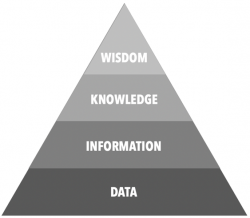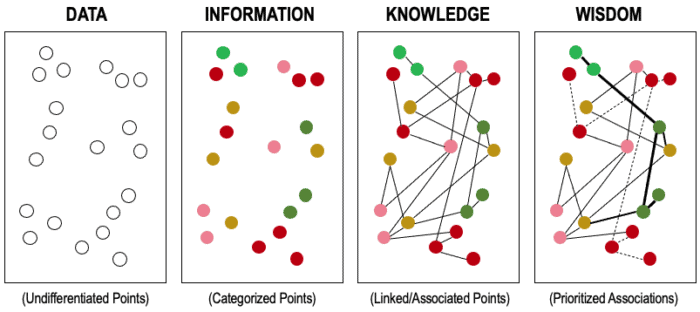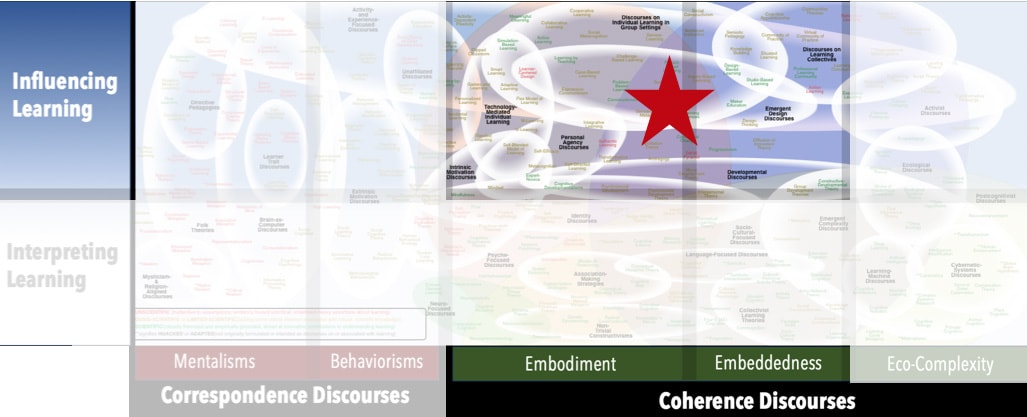AKA
Data Pyramid
DIKW Hierarchy
Information Hierarchy
Knowledge Hierarchy
Wisdom Hierarchy
Focus
Distinguishing among epistemological categoriesPrincipal Metaphors
- Knowledge is … information synthesized over time and across contexts
- Knowing is … meaning
- Learner is … information-using system
- Learning is … state-changing event
- Teaching is … varies, depending on focus
Originated
1990sSynopsis
The DIKW Pyramid is a catch-all description of several models explicating the relationships among ...- Data (Raw Data) – uninterpreted symbols,
 signals, unprocessed facts (e.g., counts, measurements, scores), unexamined images, unanalyzed recordings, etc.
signals, unprocessed facts (e.g., counts, measurements, scores), unexamined images, unanalyzed recordings, etc. - Information – data rendered useful through being organized, categorized, summarized, or otherwise structured. Of note, special categories for different types of erroneous Information have become necessary:
- Misinformation – inaccurate, unverified, or false Information
- Disinformation – inaccurate, unverified, or false Information that is spread for malicious purposes
- Knowledge – know-how, based on information synthesized over time and across contexts (A much more nuanced appreciation of popular meanings of Knowledge might be gleaned by searching the term in the Comprehensive Index. See also a more detailed definition on the Key Terms page. As well, see Deep vs. Surface Learning for some popular subcategories of Knowledge.)
- Wisdom – know-why, grounded in situated understandings, historical perspectives, critical reflection, and other applied and connected knowledge (See also Wisdom (Sagacity; Sapience), under Well-Being Discourses.)
- Ethical Know-How (Francisco Varela, 1990s) – perspective on ethics as a way of being – an everyday living in the world – that’s rooted in an ongoing practice of self-transformation. This view breaks with a prevailing view of “ethics” as a formal, conscious, and/or rule-based system of judgment.
- Principled Practical Knowledge (Carl Bereiter, 2010s) – practical know-how that is informed by scientific insights
Commentary
There are many, many variations of the concepts and distinctions addressed by the DIKW Pyramid. Differences in terminology, definition, and graphics reveal that imaginings of clear distinctions and logical hierarchies are obvious fictions – although, it would seem, not entirely un-useful, based on the resonance of the model with across so many audiences. To that end, recursive definitions of the levels out of Second-Order Cybernetics may render the model of greater use within education (e.g., data = differences; information = differences that make a difference; knowledge = awareness of differences that make a difference; wisdom = ethical action based on awareness of differences that make a difference). The following set of visual metaphors offers yet a different way to think about these categories: Additionally, several popular discourses foreground “wisdom” as a vital aspect of culture and a potential end of learning – including Constructive-Developmental Theory and many Well-Being Discourses.)
Additionally, several popular discourses foreground “wisdom” as a vital aspect of culture and a potential end of learning – including Constructive-Developmental Theory and many Well-Being Discourses.)
Authors and/or Prominent Influences
DiffuseStatus as a Theory of Learning
The DIKW Pyramid is not a theory of learning, but it can serve to orient attentions to key elements necessary in a theory of learning. For example, it is useful for separating out perspectives that address only acquisition of information.Status as a Theory of Teaching
The DIKW Pyramid is not a theory of teaching. However, it is a useful device for distinguishing among educational philosophies and the modes of teaching associated with those philosophies.Status as a Scientific Theory
The DIKW Pyramid is a catch-all that meets none of our criteria of a scientific theory.Subdiscourses:
- Data (Raw Data)
- Disinformation
- Ethical Know-How
- Information
- Knowledge
- Misinformation
- Principled Practical Knowledge
- Wisdom (Sagacity; Sapience)
Map Location

Please cite this article as:
Davis, B., & Francis, K. (2024). “DIKW Pyramid” in Discourses on Learning in Education. https://learningdiscourses.com.
⇦ Back to Map
⇦ Back to List
